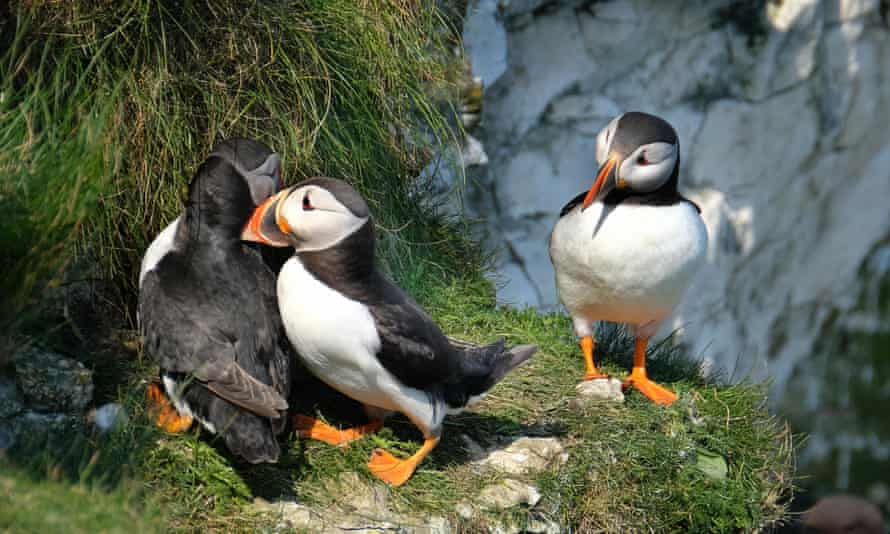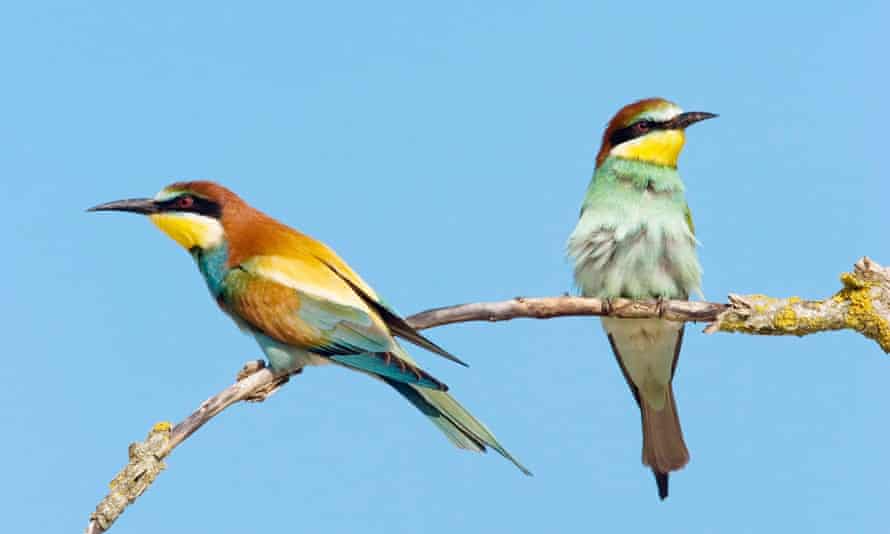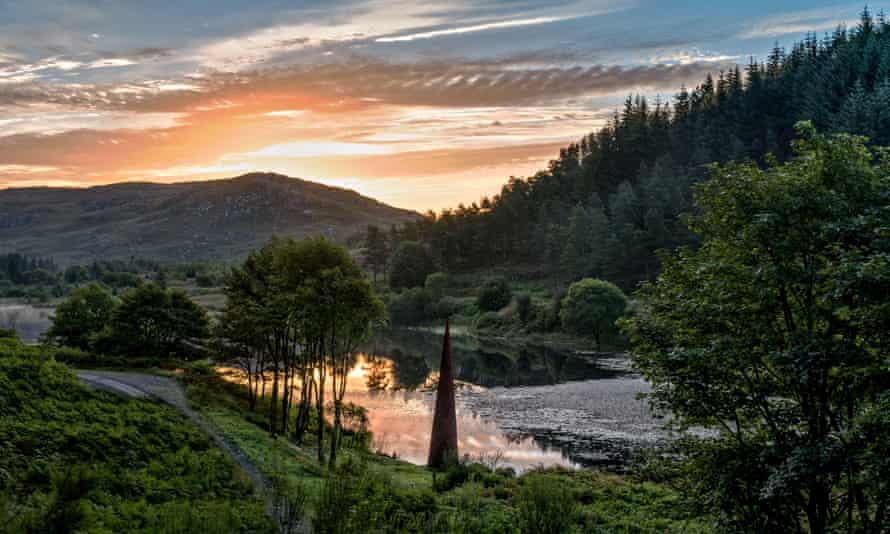Winning tip: Wheatears by the Mersey, Cheshire
The lighthouse, and the giant’s grave, in Hale village, near Liverpool, may attract many visitors to this Cheshire outpost east of John Lennon airport, but in spring, birdwatchers flock here for a different reason. The juxtaposition of the Mersey coast, saltmarshes, fields, woodlands and nearby Carr Lane Pools, provide welcome stopping off points for weary migrant bird species. First sightings of wheatears in the fields are harbingers of spring. Social media is soon buzzing with reports of buntings, warblers, whinchats, swallows and swifts. Few sites offer an opportunity to see such avian diversity in adjacent habitats. Accessible by car, cycle or public transport, Hale village presents an unmissable spring spectacle.
halevillageonline.co.uk
Jennifer Jones
Britain’s got heels, Powys
The Dyfi Osprey project based just outside Machynlleth in mid-Wales is a fabulous place where you can watch the resident ospreys, Idris and Telyn, hopefully raise their chicks to migration. You can also learn all about how ospreys have been helped to re-establish themselves in Wales. There is a superb long broadwalk down to a beautiful observatory made from reclaimed wood.
dyfiospreyproject.com
Rachel Mahar
Puffins galore, East Yorkshire

We visited Bempton Cliffs RSPB reserve last week and saw puffins aplenty flying in and out of the cliffs, gannets collecting grass for their nests flying alongside the cliffs at head height. There were tales of Albie the albatross but unfortunately we weren’t lucky enough to spot him. We did see a barn owl patrolling the adjacent fields as we left after a wonderful few hours chatting to expert bird spotters at the various viewing platforms, who were all eager to help us novices spot all the different residents. Great fun!
rspb.org.uk
freya
Mosaic of habitats, East Yorkshire

The Yorkshire Wildlife Trust’s Spurn peninsula and Kilnsea wetland complex is one of the best places to see migrating birds and access is free. A mosaic of wetland, scrub and intertidal areas provide a range of habitats for migrating birds. I make the pilgrimage every year and and usually see my first swallows, martins and cuckoos of the year. Spurn Bird Observatory runs a Twitter feed providing live updates on bird sightings across the complex, revealing locations of incoming migrant birds. The YWT’s new visitor center has a cafe serving tasty treats and offers “safari” experiences.
ywt.org.uk
rob dalziel
Birds on the Lizard, Cornwall

The extensive reed bed, maintained by the National Trust at Gunwalloe, on the Lizard in Cornwall, is an unappreciated gem for catching sight of migrating birds coming and going. The beaches close by are also a lovely spot to welcome back sand martins returning from Africa and it is often one of the first places in the UK to see swallows returning. The reed bed has recently seen several rarities including a glossy ibis, ring-necked ducks and various warbler species; in the warmer months such have also been heard of visiting bee-eaters at Gunwalloe. The reed bed also provides regular sightings of marsh harriers and starling murmurations.
Layla Astley
Feathers in the forest, Dumfries and Galloway

Photograph: Allan Wright/Alamy
Having just returned from a fortnight’s holiday in Dumfries and Galloway, we’ve made this often overlooked corner of southern Scotland our go-to for birdwatching areas (and we live in Shetland so have high standards). A huge mix of woodland birds in galloway forest park, including some firsts for us: species included pied flycatcher, treecreeper, pied (greater spotted) woodpecker, nuthatch and many warbler species. Add to this we took the Red Kite Trail through the forest roads to see hundreds of these magnificent raptors. We also saw nesting osprey at threave castle to the south-east of the park and huge numbers of wetland wading species in the coastal estuaries and flats.
Dawn
Take the tube to the wetlands, north-east London

Just 20 minutes from Oxford St, you can see a great variety of returning migratory birds at London’s beautiful nature reserve, the Walthamstow Wetlands. The whole protected area is easily reached by underground at Tottenham Hale in zone 3. Birds come to the site to feed around the 10 areas of open water and marshland. Swifts are common in spring and little ringed plovers arrive in spring, too. Much-travelled black-tailed godwits can also be seen and there’s always the chance of seeing a peregrine falcon – be patient and bring some binoculars. Enjoy the circular bird walk, viewing platforms and hiding areas. There are also weekly guided bird walks starting from the tube station in spring.
wildlondon.org.com
Greta
Pedaling past whitethroats, Cambridge

One of my favorite summer migrants is the somewhat obscure whitethroat. A member of the warbler family, they are gray and brown with – no surprise – white throats. Sometimes I just hear their tetchy alarm call or I spot them delivering their frantic burst of song from the top of a bush or when flitting between cover. On my rural cycle route to Cambridge they are dotted along the hedge at regular intervals. They can be found across the UK, apart from in urban and mountainous areas, favoring hedges and scrubland, and arrive in April from the Sahel, Africa, to breed here.
Sharon Pinner
Every week we ask our readers for recommendations from their travels. A selection of tips will be featured online and may appear in print. To enter the latest competition visit the readers’ tips homepage
–
“,”credit”:””,”pillar”:4}”>
profile
Readers’ tips: send a tip for a chance to win a £200 voucher for a Sawday’s stay
Show
Guardian Travel readers’ tips
Every week we ask our readers for recommendations from their travels. A selection of tips will be featured online and may appear in print. To enter the latest competition visit the readers’ tips homepage
–
Island of the Birds, Shetland

Fair Isle is a mecca for birdwatchers, and the great news is you can sail (or fly) there, Shetland and in the summer from Orkney. Owned by the Natural Trust since 1954, the island lies midway between Orkney and Shetland and is a haven for resident and migratory birds. With an element of adventure to get there, those intrepid enough to meet the challenge will be highly rewarded. over 391 bird species recorded, this small island has possibly the highest intensity of recorded bird life in the UK. As you stroll around Fair Isle, it is possible to see many rare species – in the past birds associated with far more southerly areas, such as hoopoe and golden oriole, have been recorded here – with more common species in abundance.
fairisle.org.uk
khalida
Poets, pier and birds, north Somerset

An excellent place for watching birds is the Clevedon seafront, including the delightful 1.5-mile Poets’Walk. Mixed habitats and big tides give a fair range of passage and migrant species including black redstart, merlin, avocet, wheatear, goosander and any number of warblers. start near the pier – described by John Betjeman as the most beautiful in England – and follow the coast path signs. It’s all free. But don’t forget your binoculars.
John
www.theguardian.com
George is Digismak’s reported cum editor with 13 years of experience in Journalism